
~~~~~~~~~~~~~~~~~~~~~~~~~~~~~~~~~~~
Frick Announces Its Most Significant Gift of Drawings and Pastels
————
Artists include Caillebotte, Degas, Delacroix, Fragonard, Goya,
Sargent, Vigée Le Brun, and Watteau
~~~~~~~~~~~~~~~~~~~~~~
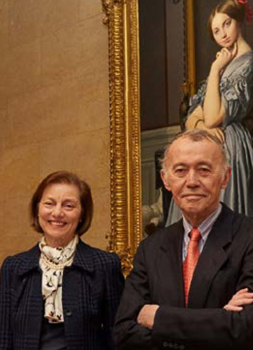 (New York, August 30, 2021) – The Frick Collection announces the largest and most significant gift of drawings and pastels in its history, thanks to the generosity of Elizabeth “Betty” and Jean-Marie Eveillard. Over the past forty-five years, the Eveillards have assembled an outstanding collection of European works on paper, ranging in date from the end of the fifteenth century to the twentieth century and representing artists working in France, Britain, Italy, Spain, and the Netherlands. The Eveillards have made a promised gift to the Frick of twenty-six of these works— eighteen drawings, five pastels, two prints, and one oil sketch—among them some of their finest acquisitions. Along with preparatory figurative sketches and independent studies and portraits are two vivid landscape scenes. Fittingly for the Frick, artists represented include François Boucher, Edgar Degas, Jean-Honoré Fragonard, Francisco José de Goya y Lucientes, Thomas Lawrence, and Jean-François Millet. The group also introduces to the Frick’s holdings works by artists not yet represented in its primary collecting areas, including Gustave Caillebotte, Maurice Quentin de La Tour, Jan Lievens, John Singer Sargent, and Elisabeth Vigée Le Brun.
(New York, August 30, 2021) – The Frick Collection announces the largest and most significant gift of drawings and pastels in its history, thanks to the generosity of Elizabeth “Betty” and Jean-Marie Eveillard. Over the past forty-five years, the Eveillards have assembled an outstanding collection of European works on paper, ranging in date from the end of the fifteenth century to the twentieth century and representing artists working in France, Britain, Italy, Spain, and the Netherlands. The Eveillards have made a promised gift to the Frick of twenty-six of these works— eighteen drawings, five pastels, two prints, and one oil sketch—among them some of their finest acquisitions. Along with preparatory figurative sketches and independent studies and portraits are two vivid landscape scenes. Fittingly for the Frick, artists represented include François Boucher, Edgar Degas, Jean-Honoré Fragonard, Francisco José de Goya y Lucientes, Thomas Lawrence, and Jean-François Millet. The group also introduces to the Frick’s holdings works by artists not yet represented in its primary collecting areas, including Gustave Caillebotte, Maurice Quentin de La Tour, Jan Lievens, John Singer Sargent, and Elisabeth Vigée Le Brun.
In the fall of 2022, at its temporary Frick Madison location, the museum will present an exhibition of these extraordinary works, to be accompanied by a catalogue and public programs.
——————-
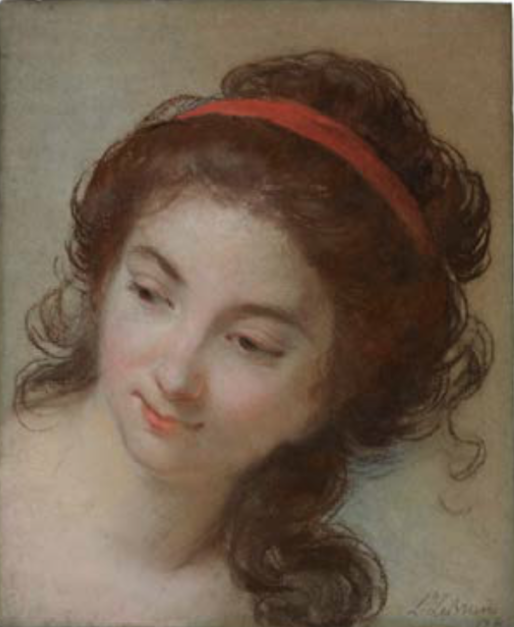
Elisabeth Vigée Le Brun, Head of a Woman, 1784, Pastel on paper, 12 x 9 7/8 inches
——————-
Comments Xavier F. Salomon, the Frick’s Deputy Director and Peter Jay Sharp Chief Curator, “It has been a pleasure studying and selecting from this remarkable collection of two longtime supporters of the Frick, assembled just as our own holdings have been, according to criteria of beauty, quality, and condition. Each of the twenty-six works either appreciably deepens our holdings of a familiar artist or brings to us the work of one who is not—but should be—represented within our core areas of European Old Master art. In adding five pastels and an oil sketch, the gift also strengthens our examples of these media. We very much look forward to sharing these works with the public next year.”
Betty and Jean-Marie Eveillard have been deeply involved with the Frick for many years, both having served as Trustees. Betty is currently the Board’s Chair.
——————-

John Singer Sargent, Virginie Amélie Avegno, Mme. Gautreau (Mme. X), ca. 1884.
——————-
The Eveillards acquired their first important work in 1975, John Singer Sargent’s Virginie Amélie Avegno, Mme. Gautreau (Mme. X), and have been active collectors ever since. This drawing is the most modern work in the promised gift to the Frick and is a particularly satisfying addition to the museum’s holdings: It is known from archival correspondence that Henry Clay Frick desired a portrait by Sargent but did not succeed in securing a sitting with the artist. Dated to about 1884, Sargent’s Mme. Gautreau is one of some dozen studies produced for the famous painted portrait Madame X, a highlight of the collection of The Metropolitan Museum of Art. This sheet shows the artist working out the figure’s pose, representing her lithe figure kneeling on a sofa and looking out a window. Sargent was captivated by Gautreau and strived in studies like this and in the final painting to capture her “unpaintable beauty and hopeless laziness.”
Other later nineteenth-century drawings coming to the Frick are by Degas and Caillebotte, selected to complement the collection’s Impressionist paintings. While the institution owns a quintessential Degas canvas of dancers, the Eveillards’ early drawing of Adelchi Morbilli, created in Naples in 1857, will be the first work on paper by the artist in the Frick’s collection. It is one of—and arguably the best of—his series of drawings of his cousin. When it was drawn,Degas was particularly interested in the work of Jean-Auguste-Dominique Ingres, and the portrait reflects this affinity. Gustave Caillebotte is best known and perhaps most celebrated for his 1877 painting at Chicago’s Art Institute, Paris Street; Rainy Day. A man of wealth, Caillebotte was also a patron and supporter of fellow Impressionist colleagues. His works only rarely appear on the market, most still being in the possession of his descendants. The promised gift includes a preparatory drawing for the iconic Paris street scene.
——————-
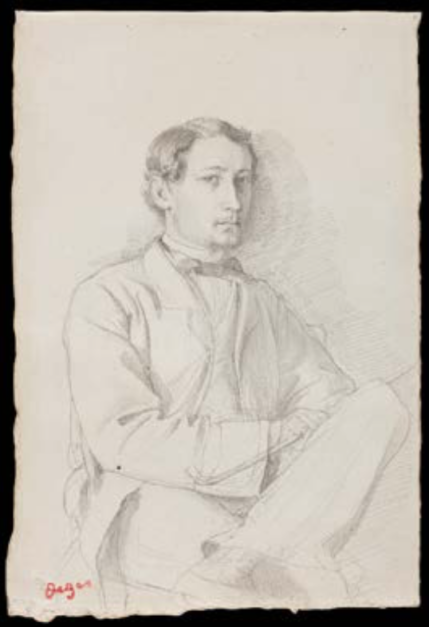
Edgar Degas, Adelchi Morbilli, ca. 1857, Graphite on paper, 9 5/8 x 6 1/2 inches.
——————-
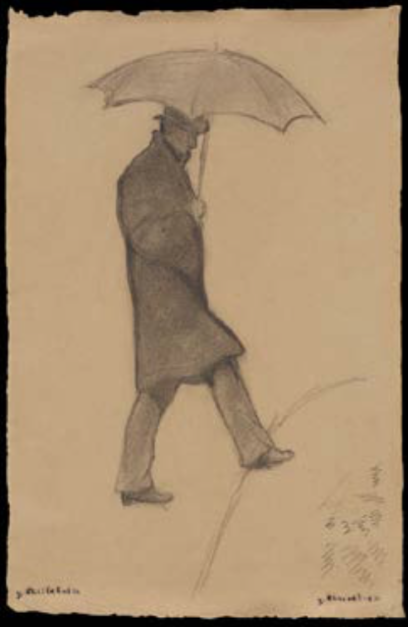
Gustave Caillebotte, Man with an Umbrella, 1877, Graphite and pencil on paper, 18 x 11 11/16 inches.
——————-
Eighteenth-century French art is one of the Frick’s strengths, with holdings by Boucher, Fragonard, Greuze, and Watteau. The gift brings to the museum works in chalk and pastel on paper by these four artists, media in which none of them is currently represented. Among these is a pastel drawing lauded by the influential writers Edmond and Jules Goncourt as one of the most beautiful by Boucher. The image of a reclining woman is associated with a pastoral painting now at the Louvre. Young Woman (“La Coquette”) by Fragonard is one of a series of spectacular drawings of female models standing outdoors. These were made in the early 1770s, contemporaneous with his creation of the four original canvases of The Progress of Love that today are a highlight of the Frick. The most renowned—and arguably the best—pastelist in eighteenth-century France was the eccentric Maurice Quentin de La Tour. The Eveillards have the finest pastel by him in private hands in the United States, the portrait of Madame Rouillé. It too comes to the Frick along with a sheet by De La Tour’s near contemporary Nicolas Lancret, neither of whom is currently represented at the museum in any medium. Widely traveled and celebrated during her life, Elisabeth Vigée Le Brun was a highly accomplished portraitist and writer. Her work also enters the collection with Head of a Woman, a sketch signed and dated 1784 and likely made in preparation for a history painting that was never executed. The scope of the institution’s French works is broadened further with sheets by Pierre-Paul Prud’hon and Jean-Baptiste Wicar.
——————-
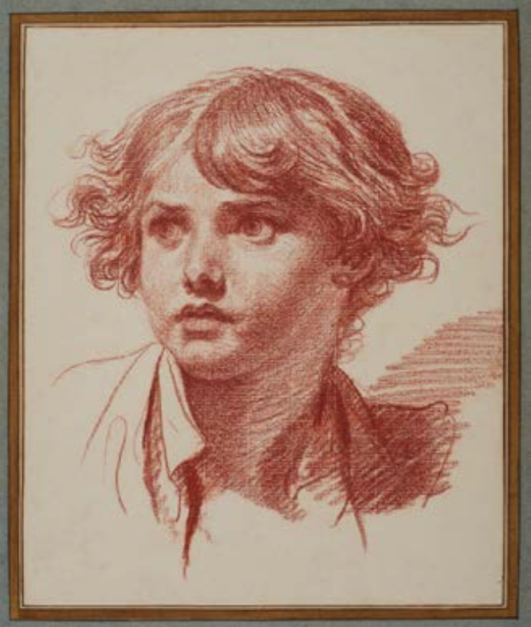
Jean-Baptiste Greuze, Head of a Boy, ca. 1777, Red chalk on paper, 15 1/2 x 12 3/4 inches.
——————-

Maurice Quentin de La Tour, Anne-Marguerite Perrinet de Longuefin, Mme. Rouillé, ca. 1738, Pastel on paper, 23 3/4 x 19 inches.
——————-
Painter Eugène Delacroix was among those artists to herald French Romanticism. In 2010, former Frick Director Charles Ryskamp left to the Frick the artist’s Moroccan Interior, a delicate and personal drawing from one of the sketchbooks Delacroix made in 1832 during a visit to North Africa. The Eveillard gift includes a pastel by the artist depicting two North African figures in a landscape, based on sketches made two decades later. Of the twenty known Delacroix pastels of such subjects, only a dozen can be located today; the Eveillard sheet is the only one in private hands, making this acquisition a particularly rare occurrence.
——————-

Eugène Delacroix, North African Man and Woman, ca. 1853, Pastel on paper, 8 9/16 x 12 1/2 inches.
——————-
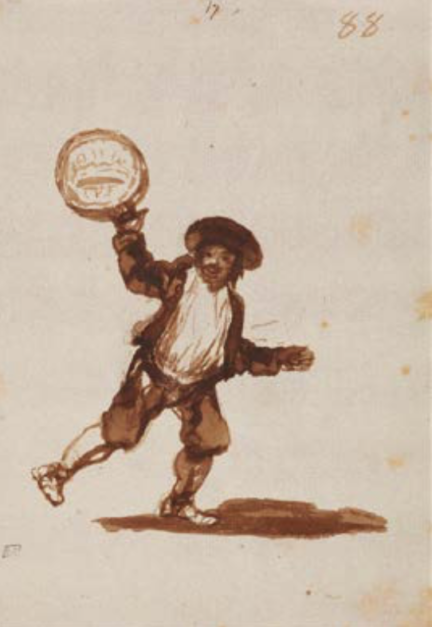
Francisco de Goya y Lucientes, Tambourine Player, ca. 1812–20, Brush and brown wash on paper, 8 1/16 x 5 5/8 inches.
——————-
The Frick is also celebrated for Spanish art, including five works by Goya: four paintings and one drawing, The Anglers. The Eveillards’ Tambourine Player will deepen the institution’s holdings by the artist. This depiction of a dancing Spanish man comes from the same album as the aforementioned drawing and likewise exemplifies the artist’s use of everyday people as subjects, as is also the case with the Frick’s large Goya painting of laborers, The Forge.
Other works in the gift enrich the Frick’s celebrated collection of Italian works, with sheets ranging from a rare anonymous fifteenth-century Venetian drawing to Italian Renaissance and Baroque sheets by Federico Barocci, Guido Reni, and Salvator Rosa and eighteenth-century works by Giovanni Battista Piazzetta and Giovanni Domenico Tiepolo. The group includes two remarkable portraits by Jan Lievens, the Dutch contemporary of Rembrandt, and by Sir Thomas Lawrence, the leading British portraitist of his age. As a young collector, Henry Clay Frick was particularly interested in the Barbizon school, and a drawing by Jean-François Millet, one of the movement’s founding members, will also enter the collection through this generous gift. The landscape joins a genre scene by Millet already in the collection. Crowning this remarkable group of works is an oil sketch by John Constable, made in preparation for the last of the artist’s famous series of “six-footer” paintings, of which The White Horse at the Frick was the first.
——————-

~~~~~~~~~~~~~~~~~~~~~~~~
BASIC INFORMATION
Website: frick.org
Building project: frickfuture.org
Bloomberg Connects app: frick.org/app
Frick Madison visitor address: 945 Madison Avenue at 75th Street, New York, NY 10021
Museum hours: Thursday through Sunday, 10:00 a.m. to 6:00 p.m.; closed Monday through Wednesday. See website for holiday schedule.
————
Admission: Timed tickets are required and may be purchased online. $22 general public; $17 seniors and visitors with disabilities; $12 students. Admission is always free for members. Pay-what-you-wish admission is offered Thursdays from 4:00 to 6:00 p.m.
————
Please note: Children under ten are not admitted to the museum.
Covid 19/health and safety policies: https://www.frick.org/visit/guidelines.
————
Ticket purchases: frick.org/tickets. For questions: admissions@frick.org
Group museum visits: Currently suspended. Please visit our website to learn more about virtual group visits. Public programs: A calendar of online events and video programs is available on our website. Shop: Open during museum hours and online daily.
Visitors are not allowed to carry items into the galleries.
—————-
Museum mailing address: 1 East 70th Street at Fifth Avenue, New York, NY 10021
Coat check: Closed until further notice.
Refreshments: A light lunch menu, offered by Joe Coffee, is available during museum hours.
Photography: Allowed only in the Frick Madison Lobby.
————
Reading room: Access is offered free by appointment Tuesday through Saturday, 10:00 a.m. to 6:00 p.m. For further information, visit frick.org/tickets.
————— Photo Credits —————
Photos are by Joseph Coscia Jr., except portrait of the Eveillards.
———————
===================================================

AAQ / Resource
space(s) Landscape Architecture
____________________________________________
